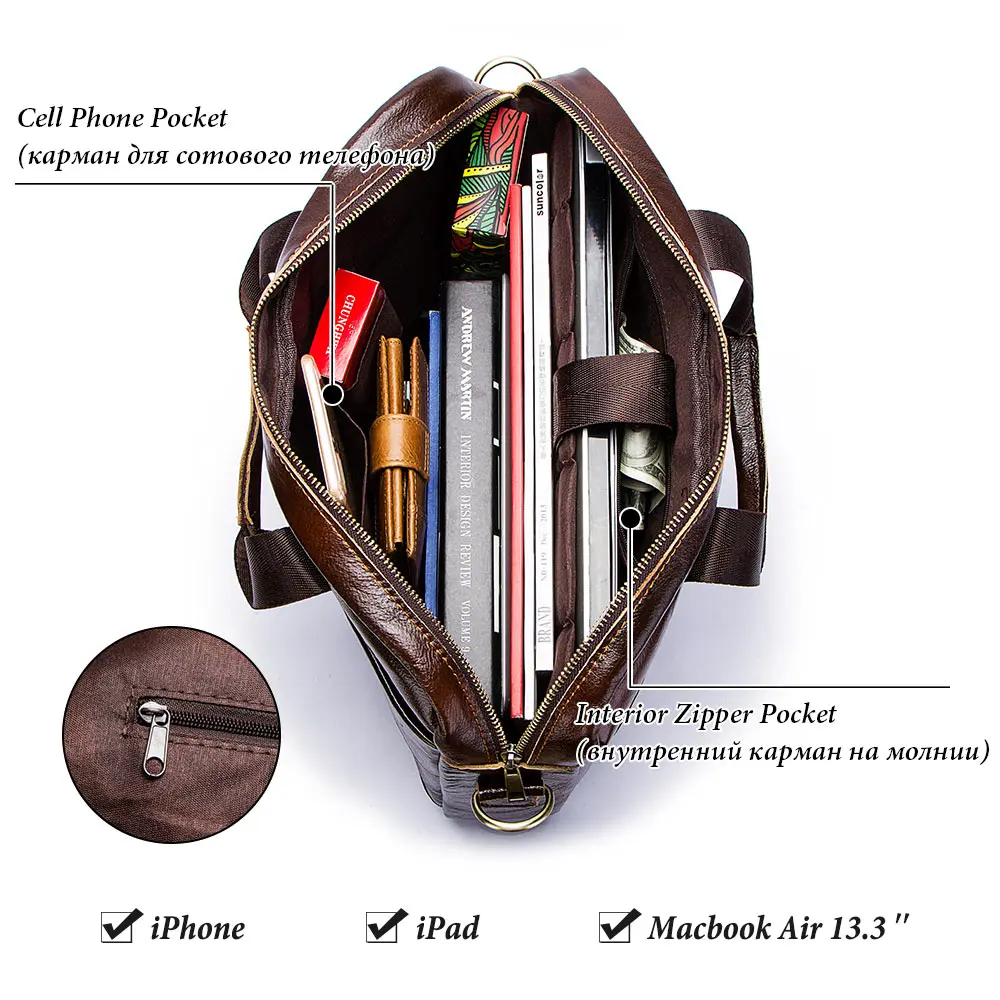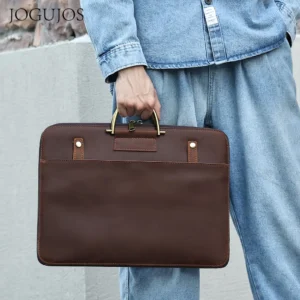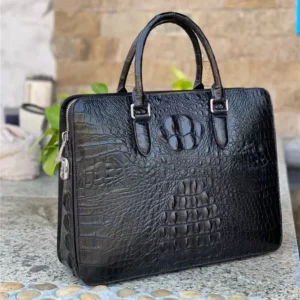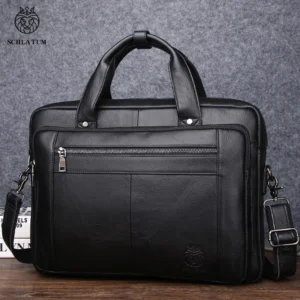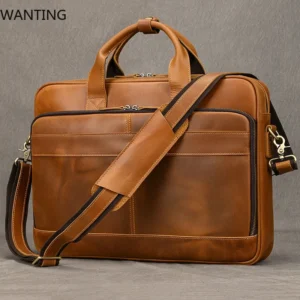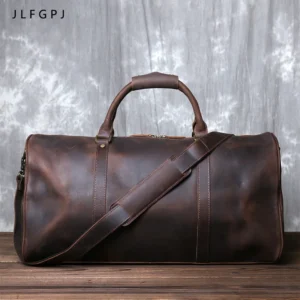Understanding the Purpose & Your Needs
A leather briefcase is far more than just a bag—it’s a professional investment that speaks volumes about your personal brand and career aspirations. These timeless accessories serve dual purposes: functionally carrying your daily essentials while making a powerful statement about your professional identity.
Before diving into materials and styles, take a moment to consider your specific requirements:
- Professional Context: Are you in a traditional field like law or finance, or a more creative industry where personal expression is encouraged?
- Daily Contents: Do you primarily carry documents, a laptop, or both? Are additional items like chargers, water bottles, or presentation materials regular necessities?
- Commute Style: Will you be walking long distances, taking public transportation, or primarily moving from car to office?
The right leather briefcase can last well beyond a decade with proper care—a stark contrast to budget options that often need replacement within 1-2 years. Consider a litigation attorney who needs organized document storage and courtroom presence versus a tech consultant requiring secure device protection and versatile carrying options.
Making timeless classic leather briefcase selections requires understanding that your investment today should serve you for years to come. Most professionals find that classic leather briefcases designed with their specific work patterns in mind offer exceptional long-term value, even when the initial cost seems significant.
The Essential Guide to Leather Quality
Understanding leather quality is crucial when selecting a briefcase that will stand the test of time. Not all leather is created equal, and knowing the differences can save you from an expensive disappointment.
Leather Grades Explained
Full-grain leather represents the pinnacle of quality. This premium material uses the entire top layer of the hide with its natural grain intact. Nothing is removed through sanding or buffing, meaning you can see the natural markings and character. Full-grain develops a beautiful patina over time, actually looking better as it ages. It’s also the most durable option, creating briefcases that can last decades rather than years.
Top-grain leather comes next in the quality hierarchy. The uppermost portion of the hide is sanded to remove imperfections, then finished with a protective coating. While this creates a more uniform appearance than full-grain, it reduces some of the leather’s natural breathability and prevents the same rich patina development. Still, it offers excellent durability and a more refined initial appearance.
Genuine leather is perhaps the most misunderstood term. Despite sounding premium, it actually refers to leather made from the lower layers of the hide after the top portions have been removed. It’s often treated with dyes and finishes to mimic higher grades. While functional, it lacks the tensile strength and aging characteristics of higher grades.
Bonded leather sits at the bottom of the quality spectrum. Similar to particle board in woodworking, it consists of leather scraps and fibers mixed with adhesives and applied to a backing. While inexpensive, it typically shows wear quickly and tends to peel or crack within a short timeframe.
Tanning Methods Matter
Vegetable tanning uses natural tannins from plant materials in a process that’s been refined over centuries. The result is a leather that develops exceptional character over time, with a warm patina that tells the story of its use. This traditional process creates a stiffer initial product that softens beautifully with use.
Chrome tanning employs chromium salts in a faster, more modern process. It produces leather that’s immediately softer and more water-resistant. However, it typically doesn’t develop the same distinctive patina as vegetable-tanned options.
When evaluating leather quality, use all your senses:
* Look for natural variations and markings in premium leathers
* Touch to feel the texture—quality leather feels naturally supple but substantial
* Smell the distinctive, rich aroma of real leather
* Listen for the subtle sound quality leather makes when handled
Understanding the best leather briefcases characteristics helps you make informed decisions about quality and value. Many professionals find that full-grain messenger bag styles offer an excellent balance of quality and functionality for daily use.
Craftsmanship & Construction Details
The distinction between an ordinary briefcase and an exceptional one often comes down to construction details that might escape casual observation. These elements determine not just how your briefcase looks, but how it performs over years of daily use.
Stitching: The Backbone of Durability
High-quality briefcases feature precise, tight stitching with strong threads that resist fraying. Look for these indicators of superior construction:
- Stitch Density: More stitches per inch typically indicate greater durability
- Saddle Stitching: This traditional hand technique creates a particularly strong seam where each stitch is individually locked
- Reinforced Stress Points: Quality briefcases have extra stitching at corners, handle attachments, and other areas that bear weight
- Thread Quality: Thick, waxed threads resist moisture and wear better than thin, unwaxed alternatives
A single loose thread isn’t merely a cosmetic issue—it’s often the first sign of future failure. Quality construction leaves no loose ends.
Hardware: Small Details with Big Impact
The metal components of your briefcase deserve careful scrutiny, as they’re often the first points of failure in lesser products:
- Brass and Stainless Steel: These materials offer superior corrosion resistance and durability compared to plated alternatives
- Weight and Feel: Quality hardware has substantial weight and smooth operation
- Zippers: YKK or RiRi brands typically indicate quality; the zipper should move smoothly without catching
- Buckles and Clasps: These should close securely with a satisfying mechanical action
Quality hardware maintains both function and appearance even after years of daily use. Corners cut here become painfully apparent within months, not years.
Interior Construction
The hidden aspects of construction often reveal the most about a briefcase’s quality:
- Edge Finishing: Properly finished edges are burnished, painted, or turned to prevent fraying and discomfort
- Lining Materials: Cotton, linen, or suede linings indicate quality; synthetic linings often indicate cost-cutting
- Reinforcement: Quality briefcases feature internal structural elements that help maintain shape even when empty
- Panel Attachment: How the various leather pieces connect reveals much about overall construction quality
Understanding durable leather briefcase options helps you identify features that contribute to longevity. Proper construction also plays a key role in preventing scratches leather briefcases experience during normal use, extending their pristine appearance.
Briefcase Styles & Design Considerations
The style of your briefcase communicates as much about you as the quality of its materials. Different designs serve different professional contexts and personal preferences, making it essential to choose one aligned with your specific needs.
Major Briefcase Styles
Classic Attaché Briefcases feature a structured, box-like design with a hinged opening at the top. These traditional options project formality and authority, making them particularly suitable for legal professionals, executives, and those in conservative industries. Their rigid structure protects documents and maintains an impeccable appearance.
Messenger-Style Briefcases offer a more relaxed professional appearance with a flap closure and typically a softer structure. These versatile options work well in modern business environments where strict formality isn’t required but professional appearance remains important. They typically offer easier access to contents while moving.
Satchel Briefcases combine elements of classic briefcases with more rugged construction. With their distinctive handle and strap configurations, these bags suit professionals who move frequently between meetings and value durability alongside professional appearance.
Slim Portfolio Briefcases present a minimalist approach for those carrying primarily flat items like laptops, tablets, and few documents. Urban professionals who value streamlined design and lighter weight often prefer these sleek options.
Color Considerations
Your briefcase color should harmonize with both your wardrobe and professional environment:
- Black projects traditional authority and pairs easily with formal attire
- Brown in various shades offers versatility and a slightly warmer professional appearance
- Tan creates a more distinctive look while remaining professional
- Burgundy/Oxblood provides a subtle distinctive option that maintains formality
Remember that lighter colors develop patina more visibly over time, while darker colors better conceal small scuffs and wear.
Size and Proportions
Your briefcase should appear proportional to your physique—too large or too small can create a visual disconnect. The ideal width typically aligns with your shoulders or appears slightly narrower, while depth should accommodate your essentials without excessive bulk.
Understanding professional leather briefcases guide principles helps match your selection to your specific work environment. Considerations about what color briefcase best suits your wardrobe can significantly impact your overall professional appearance. For those preferring minimal bulk, slim leather briefcases offer elegant alternatives without sacrificing essential functionality.
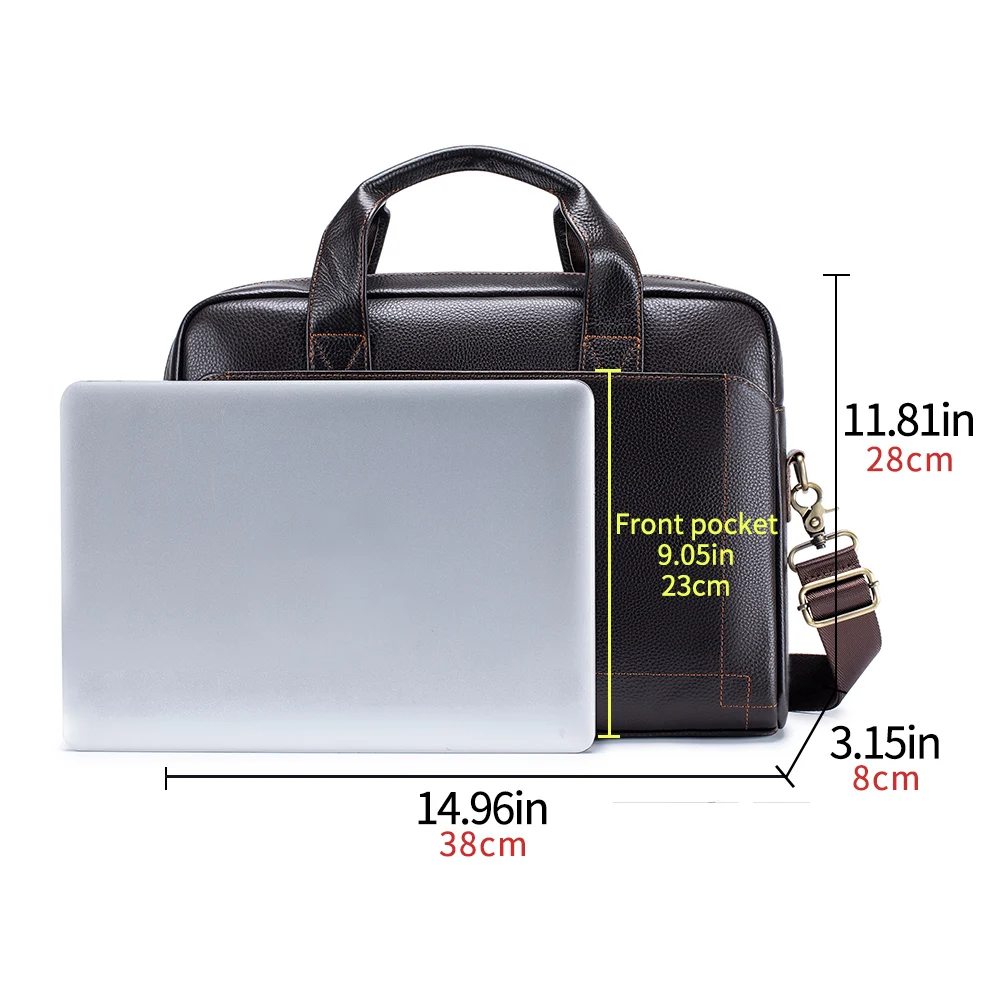
Organizational Features & Functionality
Even the most beautiful briefcase fails if it doesn’t organize your essentials efficiently. The internal design and accessibility features determine how seamlessly your briefcase integrates into your daily routine.
Essential Internal Organization
Effective organization transforms a simple carrying case into a productivity tool:
- Laptop Compartment: Look for padded protection with secure closures; verify that your specific device fits properly
- Document Organization: Separate compartments prevent important papers from bending or wrinkling
- Small Item Storage: Dedicated spaces for pens, business cards, phones, and chargers prevent damage and frustration
- Key Leash or Pocket: A secure spot for keys prevents scratching other contents
The best organization systems anticipate how you’ll use each pocket rather than simply providing generic storage.
Access Considerations
How you get into your briefcase matters as much as what it holds:
- Top-loading designs provide the easiest visual access to all contents at once
- Flap closures offer security but may require two-handed operation
- Zippered compartments provide excellent security but slower access
- Quick-access pockets positioned on exteriors balance security with convenience for frequently-used items
Consider your typical working environment—what you need at your desk differs from requirements in client meetings or during commutes.
Carrying Options
Most professionals benefit from multiple carrying methods:
- Handle construction should distribute weight evenly and provide comfortable grip
- Shoulder straps ideally feature padding, adjustability, and quality attachment points
- Luggage pass-through straps benefit frequent travelers
- Briefcase orientation when carried affects content organization and accessibility
Your carrying preference may change throughout the day based on distance, other items carried, and professional context.
Finding laptop-friendly leather briefcases that protect your devices while maintaining professional appearance requires attention to interior details. The best classic laptop briefcase designs combine device protection with traditional aesthetics.
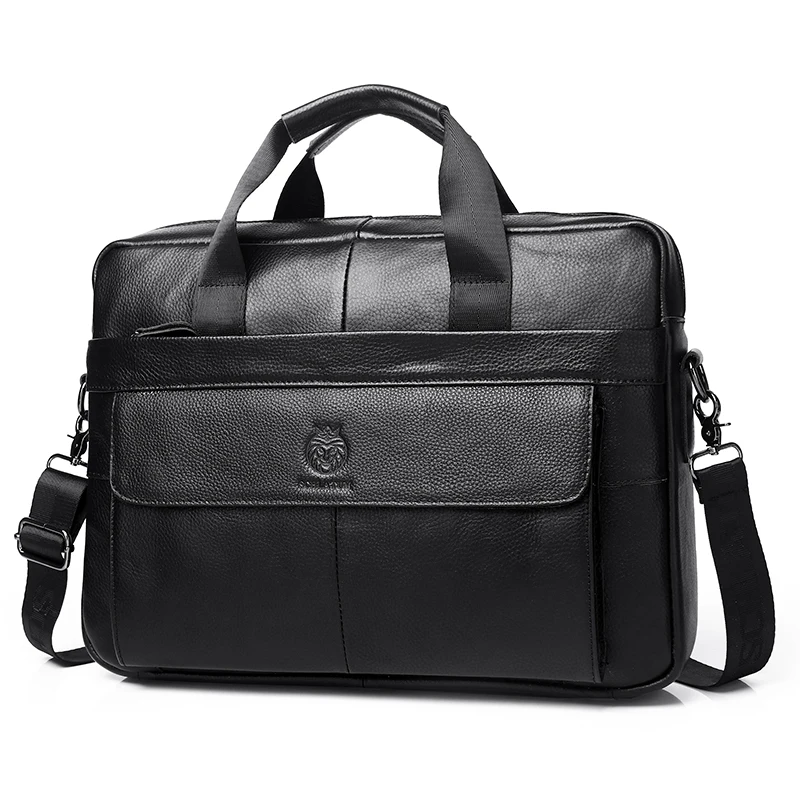
Budget Considerations & Value Assessment
Understanding the relationship between price and quality helps establish realistic expectations and identify true value in the leather briefcase market.
Price Range Expectations
Entry-Level ($100-300): At this price point, expect compromises in either leather quality or construction. While functional, these briefcases typically use genuine leather rather than full-grain, with less attention to stitching details and hardware quality. They serve as appropriate starter options but may require replacement within a few years of regular use.
Mid-Range ($300-700): This range represents the sweet spot for many professionals, offering significantly better materials and construction without reaching luxury pricing. Expect top-grain leather (possibly full-grain), quality hardware, and thoughtful organization. These briefcases typically offer excellent value, lasting 5-10 years with proper care.
Premium ($700+): High-end briefcases justify their price through superior materials (exclusively full-grain leather), exceptional craftsmanship (often including hand-stitching), distinctive design, and perfect finishing details. These investments can last decades rather than years, often developing character that makes them more appealing over time.
Value Analysis
Rather than focusing solely on purchase price, consider the annual cost of ownership:
Annual Cost = Purchase Price ÷ Years of Expected Use
A $700 briefcase lasting 15 years ($47/year) may represent better value than a $200 option requiring replacement every 2-3 years ($67-100/year)—while providing superior daily experience and professional presentation.
Consider also how your briefcase contributes to your professional image and functionality. For many, this daily-use item justifies prioritizing quality over initial savings.
Finding affordable quality leather briefcases requires knowing where manufacturers typically make compromises. Exploring various mens classic leather briefcase options helps identify where value aligns with your specific priorities.
Men's Classic Leather Briefcase, Slim Leather Laptop Briefcase, Slim Leather Portfolio Briefcase
$93.67 Select options This product has multiple variants. The options may be chosen on the product pageClassic Laptop Briefcase, Men's Classic Leather Briefcase, Slim Leather Attache Case
Price range: $353.50 through $360.81 Select options This product has multiple variants. The options may be chosen on the product pageBlack Leather Briefcase, Leather Document Bag, Men's Classic Leather Briefcase
Genuine Crocodile Leather Executive Briefcase with Password Lock – Premium Business Document Carrier$1,201.87 Select options This product has multiple variants. The options may be chosen on the product pageBlack Leather Briefcase, Classic Laptop Briefcase, Men's Classic Leather Briefcase, Slim Leather Laptop Briefcase
$228.72 Select options This product has multiple variants. The options may be chosen on the product pageBrown Leather Briefcase, Classic Laptop Briefcase, Crazy Horse Leather Satchel, Men's Classic Leather Briefcase
Price range: $172.15 through $200.02 Select options This product has multiple variants. The options may be chosen on the product pageCrazy Horse Leather Satchel, Full Grain Messenger Bag, Men's Leather Satchel
$430.41 Select options This product has multiple variants. The options may be chosen on the product page
Pre-Purchase Evaluation Checklist
Before committing to your leather briefcase investment, use this systematic approach to ensure you’re getting exactly what you expect.
Physical Inspection Guide
When evaluating in person:
Leather Assessment: Press your fingertip against the leather—quality options spring back rather than remaining indented. Smell the leather; authentic full-grain has a distinctive natural aroma.
Stitching Examination: Look for tight, even stitches with no loose threads. Check stress points like handles and corners for reinforcement.
Edge Finishing: Run your finger along edges—they should feel smooth and finished, not rough or sharp.
Hardware Testing: Open and close all clasps, buckles, and zippers multiple times. Movement should be smooth and consistent.
Weight Distribution: Fill the briefcase with your typical items and carry it briefly—weight should distribute evenly without straining specific areas.
Research Considerations
Before purchasing, particularly online:
Brand Research: Investigate the company’s history, reputation, and specialization in leather goods.
Warranty Terms: Quality manufacturers typically offer substantial warranties reflecting confidence in their products.
Return Policy: Ensure you’ll have adequate time to assess the briefcase thoroughly after receiving it.
Customer Reviews: Look specifically for long-term ownership experiences rather than initial impressions.
Online Purchase Guidance
When unable to inspect physically:
Request Additional Images: Ask for close-ups of stitching, hardware, and interior features if not provided.
Material Verification: Confirm the exact leather type and tanning method in writing.
Measurements Verification: Double-check all dimensions against your needs, particularly laptop compatibility.
The definitive guide ideal leather briefcase provides a comprehensive framework for evaluating options across all these dimensions, helping ensure your selection meets both immediate needs and long-term expectations.
Care & Maintenance Essentials
A quality leather briefcase is an investment that requires proper maintenance to reach its full potential and lifespan.
Initial Treatment
When you first receive your leather briefcase:
- Initial Conditioning: Apply appropriate leather conditioner before first use, following product-specific guidelines
- Break-In Period: Understand that full-grain leather briefcases soften and develop character with use
- Protected First Uses: Avoid exposing new leather to extreme conditions, precipitation, or potential staining situations
Your briefcase’s first few weeks of use establish patterns that affect its long-term appearance and durability.
Routine Maintenance
Develop these habits to preserve your investment:
- Regular Cleaning: Wipe down your briefcase weekly with a soft, dry cloth
- Scheduled Conditioning: Apply leather conditioner every 3-6 months (more frequently in dry climates)
- Prompt Attention to Issues: Address scratches, water exposure, or stains immediately
- Hardware Care: Periodically check and tighten screws; use appropriate metal polish sparingly when needed
Storage Practices
Proper storage significantly extends your briefcase’s life:
- Shape Retention: Store stuffed with clean paper or a briefcase insert to maintain structure
- Dust Protection: Use a dust bag or pillowcase when storing for extended periods
- Environmental Control: Store in moderate temperature and humidity, away from direct sunlight
- Avoid Compression: Don’t stack heavy items on your briefcase during storage
Understanding how maintain leather briefcase techniques ensures your investment continues to serve you well and develops an attractive patina rather than premature wear.
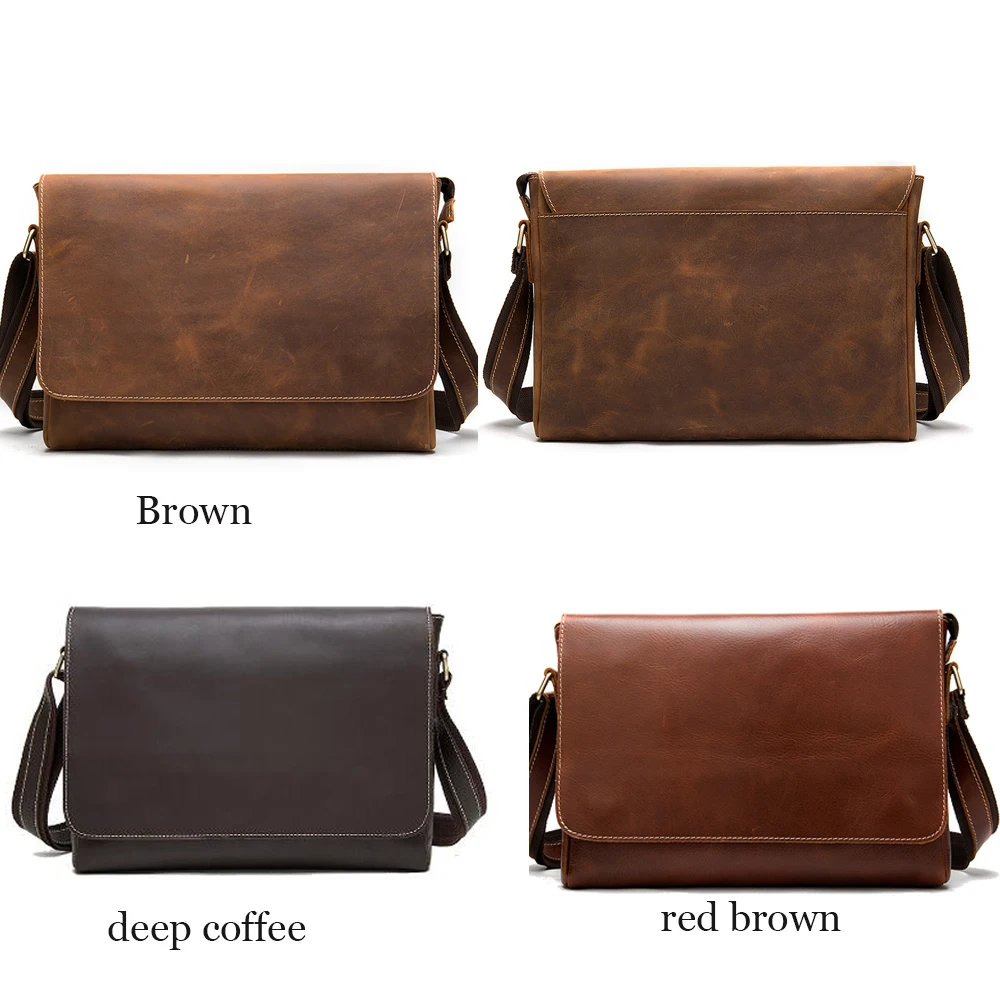
Common Mistakes to Avoid When Choosing a Leather Briefcase
Even informed buyers sometimes make avoidable errors when selecting a leather briefcase. Being aware of these common pitfalls can save you from an expensive disappointment.
Decision-Making Pitfalls
Prioritizing appearance over construction: A visually attractive briefcase with poor structural integrity quickly becomes unusable. Examine construction details as carefully as aesthetic elements.
Underestimating daily capacity needs: Many buyers choose streamlined designs only to discover they can’t accommodate their regular items. Honestly assess everything you carry daily before selecting a size.
Selecting overly trendy designs: Distinctive design elements that seem appealing today may look dated within a few years. Classic proportions and features tend to remain appropriate longer.
Ignoring weight considerations: Empty weight matters significantly when you carry your briefcase daily. Heavy briefcases can become burdensome regardless of their other qualities.
Quality Assessment Errors
Confusing genuine leather marking with quality: The “genuine leather” stamp often indicates lower-grade material, not premium quality. Learn to identify leather grades by characteristics rather than labels.
Missing hidden construction shortcuts: Manufacturers sometimes use quality materials in visible areas while cutting corners internally. Examine interior construction thoroughly.
Assuming all full-grain leather is equal: Significant quality variations exist even within full-grain leather. Source, tanning method, and finishing all impact performance and appearance.
Purchase Process Mistakes
Skipping in-person evaluation: Whenever possible, handle a briefcase before purchasing. Online images rarely reveal tactile quality indicators.
Ignoring return policy details: Some policies make returns difficult or expensive, particularly for items showing any signs of use. Understand these terms completely before purchasing.
Examining top-rated classic leather briefcases can help you understand what quality details to look for while avoiding common selection pitfalls.
Supplemental: Is a Leather Briefcase Right for Your Professional Image?
Before investing in a leather briefcase, consider whether it aligns with your overall professional presentation and industry expectations.
Professional Context Assessment
Industry Standards: Traditional fields like law, finance, and corporate management typically embrace classic leather goods as appropriate professional accessories. Creative industries often allow greater flexibility in material and design choices.
Office Culture: Consider your specific workplace environment. Some modern tech companies cultivate casual atmospheres where traditional briefcases might seem incongruously formal.
Client Expectations: If you regularly meet with clients, consider their expectations and industry standards. Your accessories should enhance their confidence in your capabilities.
Personal Brand Alignment
Style Consistency: Your briefcase should complement your overall professional wardrobe and accessories rather than creating visual discord.
Value Expression: Premium leather goods typically communicate attention to detail, appreciation for quality, and long-term thinking—consider whether these align with your personal brand.
Material Preferences: Some professionals prefer alternative materials for ethical or practical reasons. Quality options exist in canvas, technical fabrics, and synthetic materials if leather doesn’t align with your values.
Understanding how leather briefcases enhance look can help determine whether this classic accessory supports your professional image effectively.
Supplemental: What’s the Difference Between a Leather Briefcase and a Messenger Bag?
While often confused, briefcases and messenger bags serve distinctly different professional purposes through their design and functionality.
Structural Distinctions
Briefcases typically feature structured designs with formal opening systems (top handles, frame closures) that maintain shape even when empty. They project traditional professionalism and often stand upright when set down.
Messenger bags offer more casual, flexible structures with flap-over designs originally created for bicycle couriers. They conform to the body when carried and typically have a more relaxed appearance even in leather executions.
Practical Differences
Briefcases excel in formal settings, document organization, and presentation. Their structure protects contents from bending and maintains a crisp professional appearance throughout the day.
Messenger bags offer superior comfort during active commutes, easier access while standing, and generally more capacity for varied items. Their design accommodates quick transitions between carrying positions.
Contextual Considerations
Industry formality significantly impacts which style appears more appropriate. Traditional corporate environments typically favor briefcases, while creative fields and tech companies often embrace messenger aesthetics.
For professionals traversing multiple environments, the choice often depends on which setting requires more formal presentation. Some find that owning both styles provides maximum versatility across different professional scenarios.
For those considering alternatives, exploring options for choosing perfect daily messenger bag can help determine if this style better suits your specific needs.
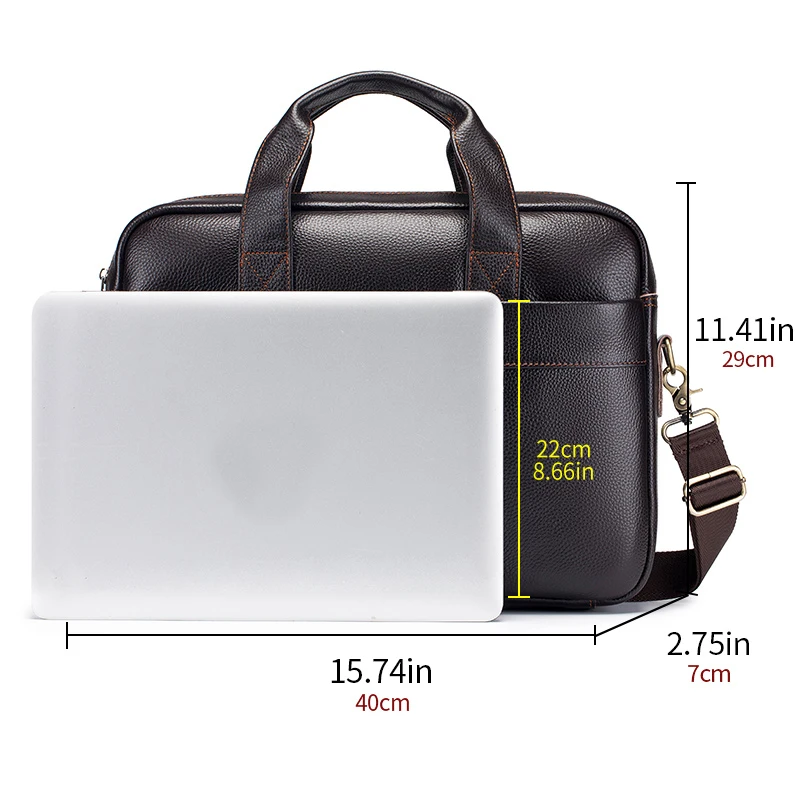
The perfect leather briefcase balances quality materials, thoughtful design, and alignment with your professional needs. At Poise Porter, we understand that a briefcase is both a functional tool and an expression of your professional identity. By carefully evaluating the elements outlined in this guide, you can select a leather briefcase that will serve you beautifully for years to come.

